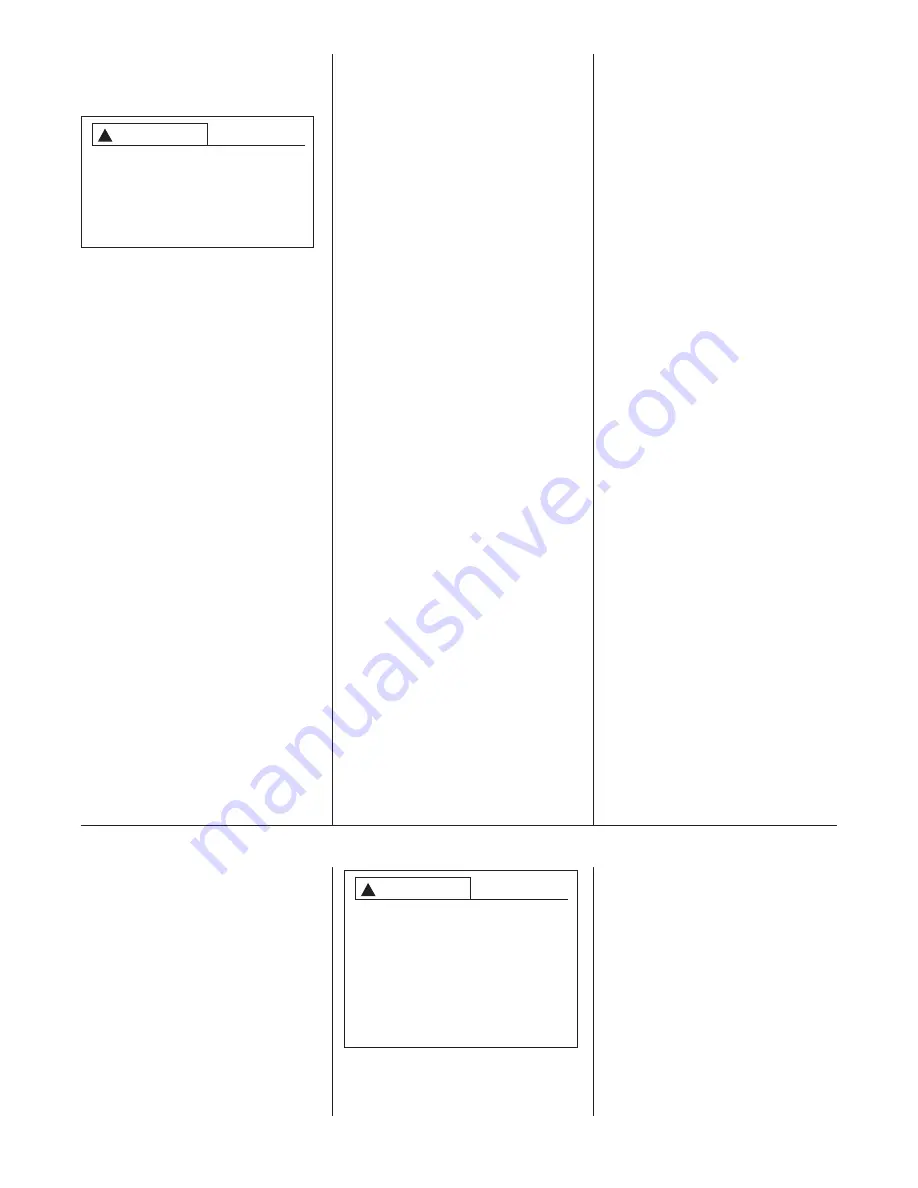
8
MODULATING FUNCTION:
(“W” and “V” signal inputs, refer to dip
switch set SW2 on IFC)
After the warm-up period, the furnace
will respond to the thermostat demand
by adjusting the gas valve pressure and
blower speed anywhere between 40% to
100% heating capacity.
➤
TWO-STAGE FUNCTION:
(Two-stage function only applies when
both switches of SW2 are in the “ON”
position and a two-stage thermostat is
installed 24V.)
After the warm-up period, the furnace
will respond to the thermostat demand
by adjusting the gas valve pressure and
blower heating speeds to the “W” signal
values. “W” only = 40% gas valve pres-
sure and blower heating speed. “W2” =
65% gas valve pressure and blower
heating speed for first five minutes and
100% thereafter. Also, if the call for heat
ends, the furnace terminates at the pre-
sent rate.
➤
SINGLE-STAGE FUNCTION:
(“W” signal only)
After the warm-up period, the furnace
will respond to the thermostat demand
by altering the gas valve pressure and
blower speed as follows:
Phase 1:
0 to 5 minutes = 40% of fur-
nace capacity (gas valve output and
blower speed)
Phase 2:
5 to 12 minutes = 65% of fur-
nace capacity (gas valve output and
blower speed)
Phase 3:
After 12 minutes = 100% of
furnace capacity (gas valve output and
blower speed)
NOTE:
If the call for heat ends during
any phase, the furnace will terminate
immediately at the firing rate of that
phase.
Heating Cycle Termination
(“W” signal only, refer to dip switch set
SW2 on IFC)
When the heat call is removed, the heat-
ing cycle will end and the furnace will
shut down and return to the proper off
cycle operation.
order listed here assumes that the fur-
nace and condenser are energized at
the same time. If not, the order of dis-
play will be in the order that the compo-
nents are turned on.
When the system has found all neces-
sary components, the text area of the
communicating thermostat will go
blank. This is an indicator that the sys-
tem is operating properly. Proceed by
engaging a typical thermostat call to
determine if operation is correct as
described in the section of this book
titled START UP PROCEDURES” to
test heating, cooling and fan operation
and to make necessary adjustments.
Heating Cycle Initiation
The heating cycle is always initiated by a
24 volt signal on W of the thermostat.
When the controller senses a heat call or
with a communicating signal from a com-
municating thermostat, the following
sequence occurs:
• High and low pressure switches are
checked to insure contacts are open.
• Inducer is powered on high speed for a
thirty (30) second prepurge.
• Pressure switches are monitored as
the inducer creates the vacuum to
close the contacts.
• The gas valve servo or solenoid is
energized at 100%. (No flow yet.)
• The controller generates a spark
across the electrodes.
• The main solenoid on the gas valve is
energized, allowing gas to flow to the
burners.
• When flame is proven, the ignition con-
trol is de-energized - 8 second maxi-
mum trial time.
• The gas valve maintains 100% rate
through the warm-up period - 20 sec-
onds.
Heating Cycle Response
The heating cycle is always initiated by a
24 volt signal on W1 or with a communi-
cating signal from a communicating ther-
mostat. When the controller senses a
heat call, the following sequence occurs:
SEQUENCE OF OPERATION
Startup For Systems Configured
With Communications
When the furnace is configured for
communications, the components on
the network (i.e. furnace, thermostat
and condenser) must establish com-
munications before engaging a heat (or
other) thermostat demand. The proce-
dure for establishing communications
is automatic and is described below.
Once the communicating wiring is
properly installed and the furnace is
connected to line voltage, the system
can be turned on. The thermostat will
display the following text :
SEARCHING
is displayed several times for several
seconds. Next, the text
FURNACE FOUND
and
AIR CONDITIONER FOUND
or
HEAT PUMP FOUND
(depending on which is installed in the
system) will be displayed. The process
can take several minutes (up to a maxi-
mum of 30) to complete. If these mes-
sages are not displayed within 30 min-
utes after energizing the system, com-
munications can not be established.
There are many reasons why commu-
nications may not be established –
including improper settings of the
“TERM” and “BIAS” switches (see
BIAS/ TERMINATION) and improper
wiring.
The order in which these messages will
be displayed will depend on which
components are energized first. The
IMPORTANT:
IT IS RECOMMENDED
THAT AN ANNUAL INSPECTION OF
YOUR FURNACE BE MADE BY A
QUALIFIED INSTALLER, SERVICE
AGENCY OR THE GAS SUPPLIER.
DURING THE ANNUAL INSPECTION,
IT IS RECOMMENDED THAT 120VAC
POWER BE TURNED OFF, THEN
BACK TO THE ON POSITION.
REAPPLYING120VAC INITIATES A
CALIBRATION CYCLE TO ENSURE
OPTIMUM SYSTEM OPERATION.
MAINTENANCE
THIS FURNACE CONTAINS
MOVING/ROTATING COMPO-
NENTS AND USES HOUSEHOLD
ELECTRICAL CURRENT. FOL-
LOW THE SAFETY RULES
BELOW TO AVOID CUTS,
BURNS OR ELECTRICAL
SHOCK WHICH CAN RESULT IN
SEVERE PERSONAL INJURY OR
DEATH.
WARNING
!
INSTALLATION OF LINE VOLT-
AGE AND GAS MUST BE PER-
FORMED ACCORDING TO
INSTRUCTIONS WRITTEN IN
THIS MANUAL. FAILURE TO DO
SO COULD RESULT IN INJURY
OR DEATH.
WARNING
!
POSSIBILITY OF BURNS
OR ELECTRICAL INJURY
• Do not perform any service or mainte-
nance on the furnace while it is oper-
ating. Read and follow the service
instructions provided with this furnace
before beginning any service or main-
tenance work.
• Do not open the blower compartment,
disassemble, or remove any compo-
nents while the furnace is operating.
This may expose sharp edges or
points which could cause cuts, hot
surfaces which could cause burns,
and electrical circuits which could
cause shocks.






























